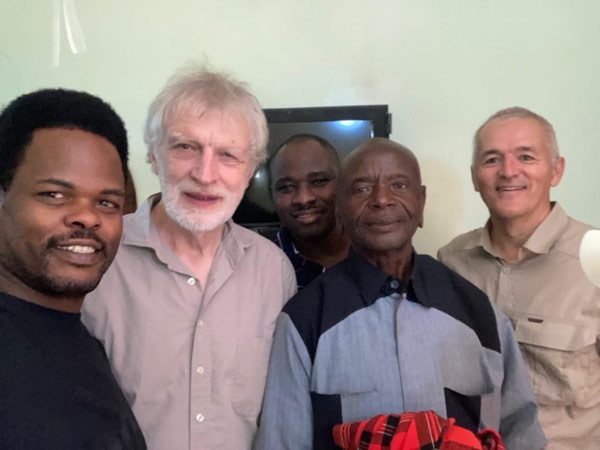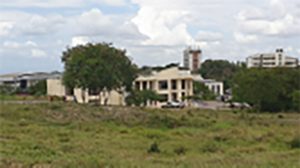June 2022
Return from a mission in Maasai country
The SYSORI project
Alain Ghio & Didier Demolin
The SYSORI project
We report on a field mission carried out in Maasai country in June 2022 by Didier Démolin, Professor of Phonetics at the Sorbonne-Nouvelle in Paris (Phonetics and Phonology Laboratory, UMR 7018) and Alain Ghio, Research Engineer at the Speech and Language Laboratory in Aix-en-Provence (UMR 7309). The objective was to record Maasai speakers around Arusha in northern Tanzania. The originality of this work lies in the experimental field approach, which consists in recording speakers on the spot using advanced laboratory techniques: aerophonometry, electroglottography, labio films, etc. The use of these techniques in the laboratory is commonplace, as are field surveys with a portable audio recorder. But doing aerophonometry in the middle of the bush is a challenge. That was the purpose of this mission involving Michael Karani, a fellow linguist from the University of Dar Es Salaam.
This was a similar mission to the one done in 2020, where the target languages were Iraqw, a Cushitic language spoken around Mbulu, and Hadza, a click language spoken by a thousand people around Lake Eyasi. This mission was the subject of a report in the CNRS journal: https://lejournal.cnrs.fr/articles/dans-le-secret-des-langues-a-clics
A Maasai speaker recorded with the EVA2 aerophonometry technique (recording of speech, vocal cord coupling, airflow and intra-oral pressure during phonation)

Scientific issues
The Great Rift Valley region of Africa encompasses several language areas belonging to the main language families of the continent (Afroasiatic, Niger-Kongo, Nilo-Saharan and Khoesan). The linguistic diversity found in northern Tanzania is the result of migrations and contacts, sometimes very ancient, between hunter-gatherer, pastoralist and agriculturalist populations. Comparison of the languages suggests several migratory phases and contacts that have repeatedly altered the language landscape. The wide geographical spread of some language families, such as Bantu, Cushitic and Nilotic, is indicative of these ancient population movements. Some of the languages of the region, such as Sandawe and Hadza, are related to the Khoesan languages of Botswana and Namibia, showing the complexity of ancient links between these populations. The Eastern Rift in Tanzania is the only place on the African continent where the four major language families of the continent (Khoesan, Niger-Congo, Afroasiatic and Nilo-Saharan) are in contact.
The linguistic context of East Africa: in grey the Khoisan languages (Hadza and Sandawe), in green the Cushitic Afro-Asian languages (including Iraqw), in light orange the Bantu languages (including Swahili) and in blue the Nilotic languages (including Maasai). Tanzania is the only point where these four major families are in contact.

The objectives
The SYSORI project aims to study the sound systems (phonetic/phonological) of Nilo-Saharan (Maasai and Akiek), Afro-Asiatic (Iraqw, Alagwa), Niger-Kongo, mixed (Mbugu) and Khoesan (Hadza, Sandawe) languages. The aim is to study and describe the production of sounds specific to these languages, such as ejective, implosive and click consonants, with particular vowel systems.

Data recorded with a Maasai speaker on the pronunciation of the word “aɓaá” which means “to crack”. Top left, sound signal. Bottom left, electroglottographic signal which reports the acceleration of the vocal cords. Top right, oral airflow, i.e. the amount of air coming out of the mouth. Bottom right, pressure inside the mouth. On /ɓ/, which is an implosive consonant, there is a clear stop of the airflow through the mouth (top right). This is called occlusion, i.e. the closing of the vocal tract. On /ɓ/ as well as on /b/, this closure occurs at the level of the lips. What is the consequence? The pressure in the mouth increases because air is still coming out of the lungs. This is the normal phenomenon on /b/. But what happens on implosives? There is an enlargement of the oral cavity and a lowering of the larynx. In the oral cavity, which is closed by the lips, the pressure drops sharply and becomes negative (visible in the lower right corner). When the lips are opened, this depression becomes audible as the air enters the oral cavity. This is the sound of the /ɓ/.
The instrumental means of the laboratory make it possible to objectify and quantify the production of these sounds in a significant way, but also to have a better understanding of the short and long term historical aspects of the evolution of the sound systems of these languages. The cooperation of our Tanzanian colleagues is essential for the successful completion of the fieldwork. In addition to the joint publications that will result from this research, we will contribute to the training of students at the University of Dar es Salaam. A teaching mission is already planned for December 2022.
From left to right: Michael Karani (UDSM), Didier Démolin (LPP, Paris), Loyewo (Arusha informant), an anonymous Maasai speaker, Alain Ghio (LPL, Aix-en-Provence)

Maasai stories
One of the objectives of the recent mission was also to collect a certain number of interjections, conatives (verbal forms expressing the idea of effort), ideophones (words aiming to express a sensation, such as a smell, a colour, a shape, a sound, a movement) typical of the Maasai language, including sounds that are not part of the phonological system of the Maasai language but which are part of their communication strategies. One session included an audio-visual recording of three ‘elders’ telling Maasai stories, allowing the language to be understood in its natural usage. A heritage value can be attributed to these recordings which archive this oral tradition which is losing ground in a society strongly marked by the use of Swahili and then English in school, as well as by the intensive use of screens leaving little or no room for these aspects.


Next missions
Autumn 2022:
- Exploratory mission at the Sandawe
December 2022:
Teaching mission to the University of Dar Es Salaam,
recordings of Maasai and Iraqw on site,
Field mission in the Usambara mountains among the Mbugu, a language that is mixed Bantu by its syntax and Cushitic by its vocabulary



